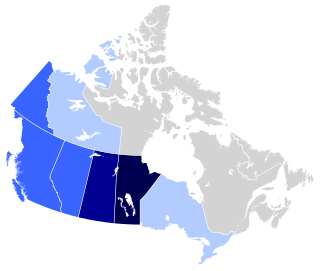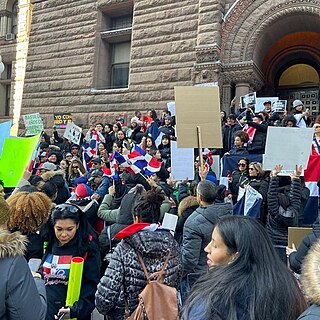Demographics
| Province | Population | Percentage | Source |
|---|---|---|---|
| 14,625 | 0.1% | [5] | |
| 14,060 | 0.2% | [6] | |
| 8,105 | 0.2% | [7] | |
| 5,700 | 0.1% | [8] | |
| 1,520 | 0.1% | [9] | |
| 865 | 0.1% | [10] | |
| 125 | 0.0% | [11] | |
| 95 | 0.0% | [12] | |
| 30 | 0.0% | [13] | |
| 30 | 0.1% | [14] | |
| 25 | 0.0% | [15] | |
| 15 | 0.0% | [16] | |
| 0 | 0.0% | [17] | |
| 45,190 | 0.1% | [1] |
This article is being considered for deletion in accordance with Wikipedia's deletion policy. Please share your thoughts on the matter at this article's deletion discussion page. |
| Total population | |
|---|---|
| 45,190' (by ancestry, 2016 Census ) [1] 26,705 (by birth, 2016 Census ) [2] | |
| Regions with significant populations | |
| Montréal, Toronto, Alberta (Edmonton) | |
| Languages | |
| Chilean Spanish, Canadian English, Canadian French | |
| Religion | |
| Roman Catholic | |
| Related ethnic groups | |
| Chilean Americans |
Chilean Canadians (French : Canadiens Chiliens) are Canadian citizens of Chilean descent or a Chile-born person who resides in Canada. According to the 2011 Census there were 38,140 Canadians who claimed full or partial Chilean ancestry. [3] The first major wave of Chilean arrival in Canada began in the second half of the twentieth century. This was also the first great wave of Latin American immigrants in Canada and the third Latin American wave in that country (though the previous two were smaller).
After the coup d'état carried out by Army General Augusto Pinochet on September 11, 1973 in Chile, which overthrew the elected government of Salvador Allende and established a military dictatorship, a significant number of Chileans emigrated to Canada in early 1974. This migration of refugees to Canada lasted until the nineties, when Pinochet's rule over Chile ended.
Although the Canadian government rejected these political refugees, the Canadian population in general had a greater acceptance of them. Groups such as the Inter-Church Committee (which later became the Inter Church Committee on Human Rights in Latin America and is now integrated in KAIROS: Canadian Ecumenical Justice Initiatives) were formed to advocate for more open doors to these refugees. Church groups like the Canadian Council of Churches, and spontaneously formed citizens' organizations, helped refugees in income and settlement of the country. Not all the population supported the newcomers, however. Small demonstrations were developed rejecting Chilean immigrants, labeling them Marxists, and supporting the coup in Chile that broke with the Socialist government, replacing it with a neoliberal dictatorship. [4]
| Province | Population | Percentage | Source |
|---|---|---|---|
| 14,625 | 0.1% | [5] | |
| 14,060 | 0.2% | [6] | |
| 8,105 | 0.2% | [7] | |
| 5,700 | 0.1% | [8] | |
| 1,520 | 0.1% | [9] | |
| 865 | 0.1% | [10] | |
| 125 | 0.0% | [11] | |
| 95 | 0.0% | [12] | |
| 30 | 0.0% | [13] | |
| 30 | 0.1% | [14] | |
| 25 | 0.0% | [15] | |
| 15 | 0.0% | [16] | |
| 0 | 0.0% | [17] | |
| 45,190 | 0.1% | [1] |
The most important consequence of the arrival of Chilean refugees to the country was the founding of organizations whose aim is to help to the country's growing Latin American community. According to studies, the Chileans who arrived in Canada after the coup in Chile brought with them political activism, which caused the formation of Chilean partnerships and associations which eventually became organizations for the Latino community in Canada. Examples of this include the Arauco cooperative housing in Toronto and various associations and publications in Alberta, as well as the television news program Nosotros (We) and the radio program Hispanoamérica in Edmonton. In other cases, Chileans formed and worked on pan-Latin American organizations that have helped political and economic refugees Hispanics adjust to life in Canada, and may be considered essential in the formation of these associations. [4]
Latin American Canadians are Canadians who are descendants of people from countries of Latin America. The majority of Latin American Canadians are multilingual, primarily speaking Spanish, Portuguese and French. Most are fluent in one or both of Canada's two official languages, English and French. Spanish, Portuguese and French are Romance languages and share similarities in morphology and syntax.
Portuguese Canadians are Canadian citizens of full or partial Portuguese heritage or people who migrated from Portugal and reside in Canada. According to the 2016 Census, there were 482,610 or 1.4% of Canadians claimed full or partial Portuguese ancestry, an increase compared to 410,850 in 2006. Most Portuguese Canadians live in Ontario - 282,865 (69%), followed by Quebec 57,445 (14%) and British Columbia 34,660 (8%).

Russian Canadians comprise Canadian citizens of Russian heritage or Russians who emigrated to and reside in Canada. According to the 2016 Census, there were 622,445 Canadians who claimed full or partial Russian ancestry. The areas of Canada with the highest percentage population of Russian Canadians are the Prairie Provinces.
Laotian Canadians are Canadian citizens of Laotian origin or descent. In the 2016 Census, 24,580 people indicated Laotian ancestry. Bilateral relations between Canada and Laos were established in 1954 with the formalization of the independence of the Kingdom of Laos from France. In August 2015, Canada's first resident diplomat opened the Office of the Embassy of Canada in Vientiane, Laos.
Trinidadian and Tobagonian Canadians are Canadian citizens who are fully or partially of Trinidadian and Tobagonian descent or persons having those origins and having Canadian citizenship. There were 78,965 Trinidadian and Tobagonian Canadians in 2016, with the majority of them living in Toronto, specifically in the Thistletown and Eglinton West neighbourhoods as well as throughout Scarborough.

Mexican Canadians are Canadian citizens of Mexican origin, either through birth or ethnicity, who reside in Canada. According to the National Household Survey in 2011, 96,055 Canadians indicated that they were of full or partial Mexican ancestry . Those born in Mexico are the largest subgroup of Latin American Canadians. Mexico-related Canadians trace their origins to Mexico, a country located in North America, bounded south from the United States. Some originate ethnically from many European countries, especially Spain, its colonial ruler for over three centuries. Canada contains the second largest population of Mexican-origin people outside of Mexico, second to the United States which has a Mexican-origin population of over 37 million.
Venezuelan Canadians are Canadian citizens of Venezuelan descent or a Venezuela-born person who resides in Canada. Venezuelan Canadians are one of more than ten Latino groups in Canada. The first Venezuelan immigrants came to Canada in the 1960s, but more than half arrived after the Venezuelan general strike of 2002-2003. Montreal, Quebec, with about 2,000, has the largest number, but in recent years, more and more families, now about 150, have settled in Calgary, Alberta and Edmonton, Alberta. Smaller communities are found in Toronto, Ontario, Ottawa, Ontario and Vancouver, British Columbia.
Brazilian Canadians or Brazo-Canadians are Canadians of Brazilian heritage, or Brazilian-born people who have immigrated to Canada.
Cambodian Canadians are Canadians of Cambodian ethnic origin or descent. There are a total of 38,490 Canadian Cambodians, most of whom reside in Toronto and Montreal.
Salvadoran Canadians (French: Salvadoriens canadiens, Spanish: Salvadoreño canadiense) are Canadian citizens who have ancestry from El Salvador, a Central American country. Per the National Household Survey in 2011, 63,965 Canadians indicated that they were of either full or partial Salvadoran ancestry, of which 43,655 (68%) are Salvadoran born. Salvadoran Canadians are primarily found in large urban areas of Ontario and Quebec, namely Toronto, Mississauga, Ottawa, Montreal and Quebec City.
Argentine Canadians are Canadian citizens of Argentine descent or an Argentina-born person who resides in Canada. The Canadian Immigration Act of 1952 resulted in an increased number of skilled and educated Argentine immigrants to Canada. The majority were fleeing the economic decline and political turmoil following the Revolución Libertadora. An average of 400 Argentines immigrated to Canada annually from 1964 to 1972. Beginning in 1973, increased instability, terrorism and high inflation in Argentina created another wave of immigration to Canada. The rate of immigration increased to more than 1000 persons annually during the mid-1970s. The influx lasted until 1983, coinciding with the progress of Argentine democracy. The highest concentrations of Argentine Canadians are in Toronto, Ontario and Montreal, Quebec.
Uruguayan Canadians are Canadian citizens of Uruguayan descent or persons of Uruguayan descent residing in Canada. Uruguayans who have immigrated to Canada. According to the 2016 Census there were 6,795 Canadians who claimed full or partial Uruguayan ancestry. Modern estimates put the figure of people with at least some Uruguayan heritage in Canada at about 20,000.
Cuban Canadians are Canadian citizens of Cuban descent or a Cuba-born person who resides in Canada. According to the 2011 Census there were 21,440 Canadians who claimed full or partial Cuban ancestry. Canada is home to the third largest Cuban immigrant community in the world after the United States and Spain.
Peruvian Canadians are Canadian citizens of Peruvian descent or a Peru-born person who resides in Canada. According to the 2016 Census there were 42,145 Canadians who claimed full or partial Peruvian ancestry. The largest Peruvian Canadian community exists in the francophone province of Quebec.
Colombian Canadians are Canadian citizens of Colombian descent or Colombian-born people who reside in Canada. They can be Canadian Born citizens who become nationalized in Colombia too. According to the 2011 Census there were 76,580 Canadians who claimed full or partial Colombian ancestry. Colombian Canadians are the largest South American immigrant group in Canada and the second Latin American immigrant group after Mexican Canadians. Of the Colombian Canadians that have been nationalized in Colombia, some are found living in the Antioquia department region.
Ghanaian Canadians are Canadians of full or partial Ghanaian ancestry. Ghanaians who became naturalized citizens of Canada preferably refer to themselves as Ghanaian Canadians.

Dominican Canadians are Canadian citizens of Dominican descent or Dominican Republic-born people who reside in Canada. According to the 2016 census, there were 23,130 Canadians who claimed full or partial Dominican ancestry.
Puerto Rican Canadians are Canadian citizens of Puerto Rican descent or Puerto Rico-born people who reside in Canada. According to the 2016 census, there were 3,410 Canadians who claimed full or partial Puerto Rican ancestry.
Guatemalan Canadians are Canadian citizens of Guatemalan descent or Guatemalan-born people who reside in Canada. According to the 2016 census, there were 26,270 Canadians who claimed full or partial Guatemalan ancestry.
Honduran Canadians are Canadian citizens of Honduran descent or Honduran-born people who reside in Canada. According to the 2016 census, there were 10,650 Canadians who claimed full or partial Honduran ancestry.